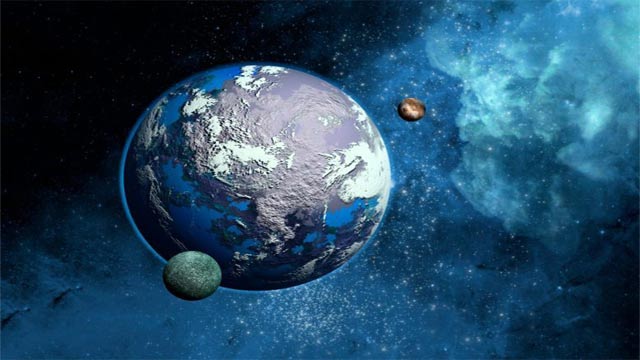According to a statement that it calls “incredibly rare,” New Zealand Astronomers say the planet is “one of only a handful discovered with a size and orbit comparable to that of Earth”. The discovery research was recently published in a study published in the Astronomical Journal. How do we compare this distant world and its star with our neighborhood? According to the study, the host star of the super earth is about 10 percent of the mass of our sun, and somewhere between that of the earth and Neptune the planet would have a mass. It would also orbit its star somewhere between Venus and Earth.
Regarding life or water, however, the study’s authors suggest that we should have no hopes: “Although it is not too big as Earth and orbits its star at a similar distance, this planet will be very cold because of its star is smaller than the sun and emits far less light, ”said study co-author Michael Abrow of Canterbury University of New Zealand in a statement.
Water does not survive in a liquid state, so there would be a very low chance of existence,” he said. “We have found only a few planets that might have suitable conditions for life.”
Another difference: Due to the smaller mass of the host star than our own, the planet will have a “year” of around 617 days. Antonia Herrera-Martin, the lead author of the study, also from the University of Canterbury, said the planet was discovered using a technique called gravitational microlens. “The combined gravity of the planet and its host star caused a particular increase in the light from a distant background star,” he said. “We used telescopes around the world to measure the light bending effect.” The microlens effect is unusual, he said: at any given time, it affects only about one in a million stars in the galaxy. Therefore, this form of observation will not take place, and at the same time, the probability of catching a planet is extremely low, said Martin.
ون ملین میں دریافت: سائنس دانوں نے سپر ارتھ کو “حیرت انگیز نایاب” کے طور پر دریافت کر لیا
ایک بیان کے مطابق جس میں اسے “حیرت انگیز طور پر نایاب” کہا جاتا ہے ، نیوزی لینڈ کے ماہر فلکیات کا کہنا ہے کہ یہ سیارہ “زمین کے موازنہ کے حجم اور مدار کے ساتھ صرف ایک مٹھی بھر میں دریافت ہوا ہے”۔ اس دریافت کی تحقیق کو حال ہی میں فلکیاتی جریدے میں شائع ہونے والی ایک تحقیق میں شائع کیا گیا تھا۔ ہم اس دور دُنیا اور اس کے ستارے کا اپنے پڑوس سے کیسے موازنہ کریں؟ اس تحقیق کے مطابق ، سپر زمین کا میزبان ستارہ ہمارے سورج کے بڑے پیمانے پر 10 فیصد ہے ، اور کہیں زمین اور نیپچون کے بیچ سیارے کا ایک وسیع حصہ ہوگا۔ یہ وینس اور زمین کے درمیان کہیں بھی اپنے ستارے کا چکر لگائے گا۔
تاہم ، زندگی یا پانی کے بارے میں ، اس مطالعے کے مصنفین کا مشورہ ہے کہ ہمیں کوئی امید نہیں رکھنی چاہئے: “اگرچہ یہ زمین کی طرح اتنا بڑا نہیں ہے اور اپنے ستارے کو ایک ہی فاصلے پر چکر لگاتا ہے ، لیکن یہ سیارہ بہت سرد ہوگا کیونکہ اس کا ستارہ اس سے چھوٹا ہے۔ سورج اور کہیں کم روشنی کا اخراج ، “نیوزی لینڈ کی کینٹربری یونیورسٹی کے مطالعہ کے شریک مصنف مائیکل ابرو نے ایک بیان میں کہا۔
ایک اور فرق: ہمارے اپنے مقابلے میں میزبان ستارے کے چھوٹے پیمانے پر ہونے کی وجہ سے ، کرہ ارض کا لگ بھگ 617 دن ہوگا۔ اس مطالعہ کے مرکزی مصنف ، انٹونیا ہیریرا مارٹن ، کینٹربری یونیورسٹی سے تعلق رکھنے والے ، نے کہا کہ اس سیارے کو کشش ثقل مائکرویلینز نامی ایک تکنیک کے ذریعے دریافت کیا گیا تھا۔ انہوں نے کہا ، “سیارے اور اس کے میزبان ستارے کی مشترکہ کشش ثقل کے باعث دور دراز کے پس منظر والے ستارے سے روشنی میں خاص اضافہ ہوا ہے۔” “ہم روشنی کے موڑنے والے اثر کو ماپنے کے لئے پوری دنیا میں دوربین کا استعمال کرتے ہیں۔” مائکرولنز کا اثر غیر معمولی ہے ، انہوں نے کہا: کسی بھی وقت ، یہ کہکشاں کے دس لاکھ ستاروں میں سے صرف ایک پر اثر انداز ہوتا ہے۔ لہذا ، مشاہدے کی یہ شکل نہیں آئے گی ، اور اسی کے ساتھ ہی ، کسی سیارے کو پکڑنے کا امکان بھی انتہائی کم ہے ، مارٹن نے کہا۔






















